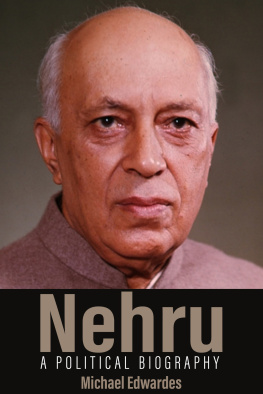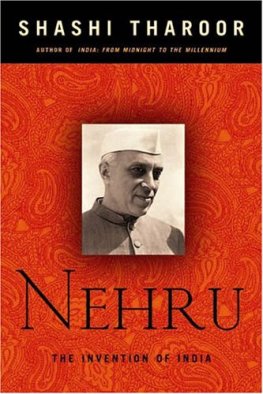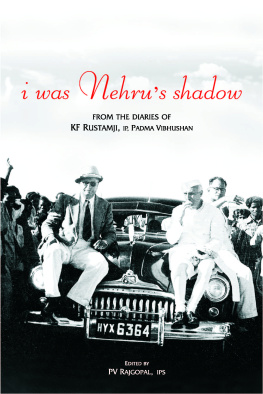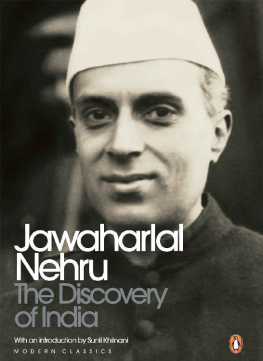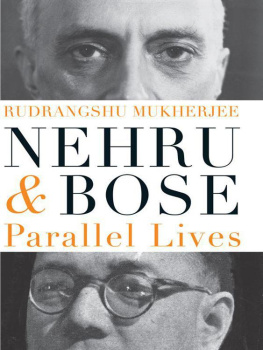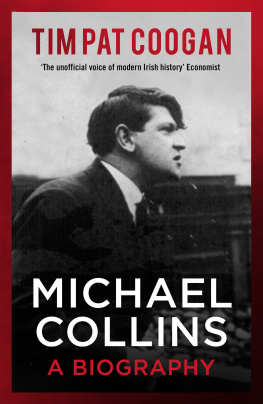Michael Edwardes - Nehru: a political biography
Here you can read online Michael Edwardes - Nehru: a political biography full text of the book (entire story) in english for free. Download pdf and epub, get meaning, cover and reviews about this ebook. year: 1971, publisher: Allen Lane, genre: Politics. Description of the work, (preface) as well as reviews are available. Best literature library LitArk.com created for fans of good reading and offers a wide selection of genres:
Romance novel
Science fiction
Adventure
Detective
Science
History
Home and family
Prose
Art
Politics
Computer
Non-fiction
Religion
Business
Children
Humor
Choose a favorite category and find really read worthwhile books. Enjoy immersion in the world of imagination, feel the emotions of the characters or learn something new for yourself, make an fascinating discovery.
- Book:Nehru: a political biography
- Author:
- Publisher:Allen Lane
- Genre:
- Year:1971
- Rating:4 / 5
- Favourites:Add to favourites
- Your mark:
- 80
- 1
- 2
- 3
- 4
- 5
Nehru: a political biography: summary, description and annotation
We offer to read an annotation, description, summary or preface (depends on what the author of the book "Nehru: a political biography" wrote himself). If you haven't found the necessary information about the book — write in the comments, we will try to find it.
Nehru: a political biography — read online for free the complete book (whole text) full work
Below is the text of the book, divided by pages. System saving the place of the last page read, allows you to conveniently read the book "Nehru: a political biography" online for free, without having to search again every time where you left off. Put a bookmark, and you can go to the page where you finished reading at any time.
Font size:
Interval:
Bookmark:
| Nehru: A Political Biography | |
| Michael Edwardes | |
| Allen Lane & Riddler (1971) | |
| Rating: | ***** |
| Tags: | Biographies, Politicians, India, Prime Ministers, Banned |
| Biographiesttt Politiciansttt Indiattt Prime Ministersttt Bannedttt |
Michael Edwardes Has Written A Political Biography.
It Is Concerned With Nehru`S Formation As A Politician, His Rise From A Rich Indian Background, His Aristocratic Education, His Odd Relationship To Hinduism And His Fatal Inability To Survive On His Own.
Nehru
A Political Biography
Michael Edwardes
VIKAS PUBLICATIONS
5 Daryaganj, Ansari Road, Delhi-6
Savoy Chambers, 5 Wallace Street, Bombay-1
10 First Main Road, Gandhi Nagar, Bangalore-9
80 Canning Road, Kanpur
Mount Drive, North Harrow, Middx, England
Copyright Michael Edwardes, 19ftl
First published in 1981 by Allen Lane The Penguin Press
Printed in Great Britain
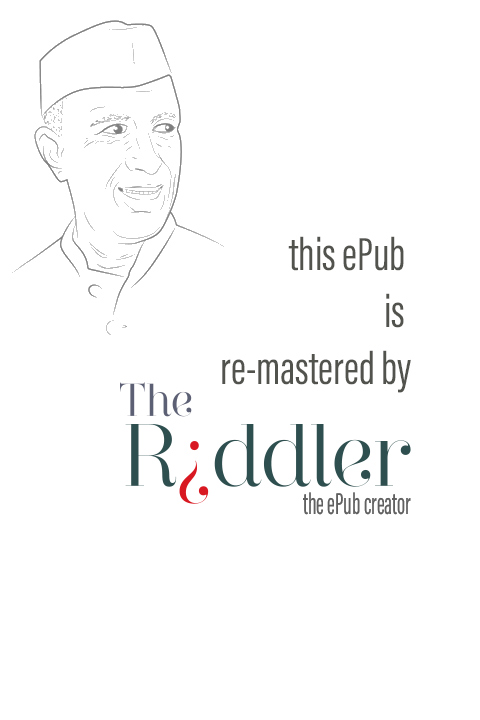
Earthquake in Delhi
A little before midday on Thursday 27 May 1964, New Delhi was shaken by an earthquake. Such seismic disturbances are not unusual in Indias capital city, but this one was very appropriately timed and not without a certain obvious symbolism. The day before had died Pandit Jawaharlal Nehru - nationalist leader, heir of Mahatma Gandhi, one of the architects of independent India and its first Prime Minister. A few moments after the tremor, the gates of his residence, where some half a million people had filed past the body on its raised wooden platform, were closed. Some of the crowd tried to climb over the gates for a last look at the man who had led them, lectured them, sometimes even bullied them, and had received from them in return reverence and affection. As they were driven away by the guards, three people were trampled to death and others were injured.
Inside the vast grounds of what before independence had been the mansion of the British commander-in-chief, the body was lifted on to a gun-carriage, the head slightly raised and the rest covered by an Indian flag. The day was very hot and the flowers spread over the bier began to wilt. In the oppressive and sickly air were the sounds of Sanskrit mantras, chanted by a group of Hindu priests, and the rather banal English words of Abide with Me, sung by a number of Christians for the only apparent reason that it had been one of Gandhis favourite hymns.
At 1.20 p.M. the cortege was ready to move. In front was a jeep carrying the general commanding the Delhi area. Then the gun-carriage, drawn by men of the services, with others, arms reversed, marching in slow time on either side. Behind followed a number of motor cars. In the first, in a white sari Nehrus daughter, Indira Gandhi, with her younger son, Sanjay. As Nehru had no son, it would be Sanjay who lit the funeral pyre that waited six miles away on the banks of the sacred River Jumna, near the place where sixteen years before the body of Gandhi had been cremated. Behind the first car were others, with Nehrus sisters and more members of his family, political leaders, and the representatives of foreign states who had been arriving throughout the night and the morning.
The route followed was very much the same as that along which Gandhi had made his last journey. Past the grandiose Government buildings erected by the British in the last years of their own rule, the procession moved slowly. Past the Parliament House, down the great ceremonial way of Rajpath, down the Tilak marg, named after another Indian nationalist long dead, and finally to the cremation ground with its plain brick plinth, five feet high and ten feet square, surmounted by a pyre of sandalwood.
Along the way the vast crowds, as many as three million people according to some reports, pressed against the police and troops lining the route. It was very much an Indian crowd, boisterous, inquisitive, with tears and laughter intermixed, reverent but undisciplined. At one place the bier and the first couple of cars were cut off from the remainder of the procession as the crowd surged across the road. But at last, at four oclock, the cortege arrived on the banks of the river. To the sound of muffled drums the body was placed on the pyre. Hindu priests began the magical rites for the dead, holy water from the River Ganges was sprinkled, a small group of leaders filed past, each placing a piece of sandalwood on the pyre. The Indian flag was replaced with a white scarf and flower petals. Sanjay lit the pyre and the body of Jawaharlal Nehru, socialist, agnostic, prophet of Indian secularism, went up in flames like that of a Hindu king.
The whole affair had appeared to many as a display of bizarre incongruities. Nehrus Will, written ten years before his death, had laid down that no religious ceremonies should be associated with his funeral. Among those who placed a final piece of sandalwood on his pyre were such Muslims as the Vice-President of India, and Sheikh Abdullah, the Kashmir leader. And, as the sacred mantras droned on, there was a volley of rifle shots and twenty-four bugles blared out the Last Post. Yet none of these contradictions was without its point or its relevance to Nehrus own life and personality. The Eurasian overtones of the funeral, those elements of east and west which some saw as being in execrable taste, had been as much a part of the living Nehru as they were of his death. The Muslims who willingly took part in a Hindu ceremonial represented not only the special place the Muslim world had occupied in Nehrus political life but also his antecedents, for his family background had been significantly influenced by the pre-British Muslim rulers of India - the Mughals.
Even when everyone except the priests and a few soldiers had left the cremation ground - the family, the cabinet ministers now more concerned with the succession, and the foreign dignitaries anxious about the outcome - the apparent paradoxes of Nehrus death were still not complete. On the following day, the Indian President with several Cabinet ministers and members of the dead Prime Ministers family attended the collection of the ashes. These were put into copper urns, sprinkled with water from the Ganges, and taken to Nehrus house. There in the garden they remained while thousands of people paid them homage.
The final act took place on Tuesday 9 June, not at Delhi but near Nehrus birthplace of Allahabad. There the River Ganges joins the Jumna at a spot particularly sacred to Hindus. In his Will, which had been read over the radio by the elder of his sisters a few days before, Nehru had asked that some of his ashes be thrown into the Ganges. He disclaimed any religious implication. For him, he said, the Ganges was a symbol of Indias age-long culture and civilization, ever changing, ever flowing, and yet ever the same. She reminds me of the snowcovered peaks and deep valleys of the Himalayas which I have loved so much and of the vast plains below where my life and work have been cast. The remainder of the ashes should, he wrote, be carried up into the air in an aeroplane and scattered from that height over the fields where the peasants of India toil, so that they might mingle with the dust and soil of India and become an indistinguishable part of India.
The ashes were brought by train from Delhi and crowds lined the tracks. A huge assembly awaited them at Allahabad. With Nehrus ashes came an urn containing those of his wife, Kamala, which Nehru had kept in his room for the twentyeight years since her death. At Allahabad the urns were placed under a tree near the house where Nehru had spent his childhood. Again, there were flowers and quiet adoration. Then, surrounded by soldiers and priests they were taken to the bank at the sacred spot and ferried out to the confluence of the rivers. There they were scattered. A helicopter showered flower-petals, guns boomed out, mantras were chanted, buglers blew the Last Post again, and a military band - its members almost certainly all good Hindus - played Abide with Me.
Font size:
Interval:
Bookmark:
Similar books «Nehru: a political biography»
Look at similar books to Nehru: a political biography. We have selected literature similar in name and meaning in the hope of providing readers with more options to find new, interesting, not yet read works.
Discussion, reviews of the book Nehru: a political biography and just readers' own opinions. Leave your comments, write what you think about the work, its meaning or the main characters. Specify what exactly you liked and what you didn't like, and why you think so.

